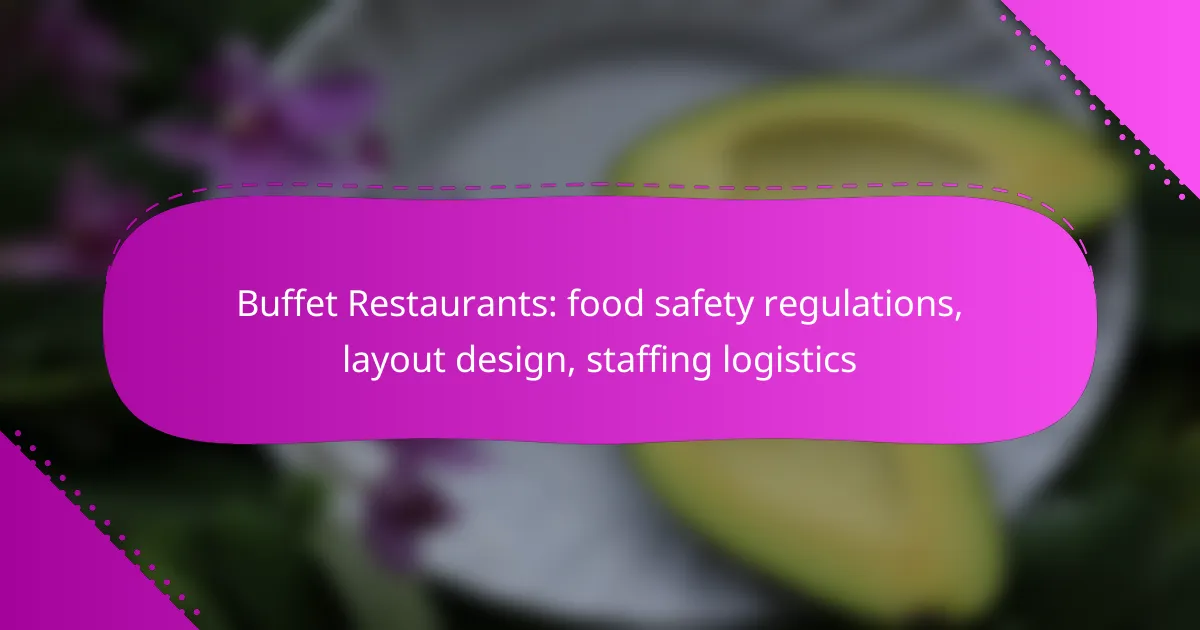Buffet restaurants must navigate a complex landscape of food safety regulations to protect their customers, adhering to both Health Canada guidelines and provincial standards for food handling and preparation. Additionally, thoughtful layout design is essential for optimizing customer experience and service efficiency, while effective staffing logistics play a critical role in ensuring smooth operations and high levels of customer satisfaction.

What are the food safety regulations for buffet restaurants in Canada?
Buffet restaurants in Canada must adhere to strict food safety regulations to ensure the health and safety of their patrons. These regulations encompass guidelines from Health Canada as well as provincial standards that govern food handling, storage, and preparation practices.
Health Canada guidelines
Health Canada provides comprehensive guidelines that buffet restaurants must follow to maintain food safety. These include proper food handling techniques, temperature control for hot and cold foods, and hygiene practices for staff. Buffets must ensure that food is kept at safe temperatures, typically above 60°C (140°F) for hot foods and below 4°C (39°F) for cold items.
Additionally, Health Canada emphasizes the importance of regular training for staff on food safety practices. This training should cover topics such as cross-contamination prevention and the importance of personal hygiene.
Provincial food safety standards
Each province in Canada has its own food safety standards that complement Health Canada’s guidelines. For example, Ontario’s Food Safety and Quality Act outlines specific requirements for food establishments, including buffets. These regulations may include licensing requirements, inspections, and compliance with local health unit standards.
Restaurants must familiarize themselves with their province’s regulations, as these can vary significantly. Regular inspections by local health authorities ensure compliance and help identify potential issues before they become serious problems.
Common violations to avoid
Buffet restaurants often face common violations that can jeopardize food safety. One major issue is improper temperature control, where food is not maintained at safe temperatures, leading to bacterial growth. Restaurants should regularly monitor food temperatures and use calibrated thermometers to ensure compliance.
Another frequent violation is inadequate staff training on hygiene practices. Employees should be trained to wash hands frequently and avoid cross-contamination by using separate utensils for different food items. Regular refresher courses can help maintain high standards of food safety.

How should buffet restaurant layouts be designed?
Buffet restaurant layouts should be designed to enhance customer experience while ensuring efficient food service. Key elements include optimal food station arrangement, effective traffic flow, and adherence to accessibility standards.
Optimal food station arrangement
Food stations should be strategically placed to minimize congestion and maximize accessibility. Grouping similar items together, such as salads, main courses, and desserts, allows customers to navigate the buffet more easily. Consider using a circular or linear layout to facilitate movement.
Additionally, ensure that hot and cold items are appropriately separated to maintain food safety. Use clear signage to guide customers to different stations, which can help reduce confusion and streamline the dining experience.
Traffic flow considerations
Effective traffic flow is crucial in buffet design to prevent bottlenecks and ensure a pleasant dining experience. Aim for a layout that allows for a clear entry and exit path, with ample space for customers to move around without feeling cramped.
Implementing one-way traffic patterns can help manage flow, directing diners in a consistent direction. Consider the placement of tables and chairs to avoid obstructing pathways, allowing for easy access to food stations.
Accessibility standards
Adhering to accessibility standards is essential for accommodating all guests. Ensure that buffet stations are at a height that is accessible for individuals using wheelchairs or those with mobility challenges. Providing ample space between stations and seating areas is also important for easy navigation.
Incorporate features such as non-slip flooring and clear signage in large print to enhance safety and usability. Regularly review and update your layout to comply with local regulations and best practices for accessibility.

What staffing logistics are essential for buffet restaurants?
Effective staffing logistics are crucial for buffet restaurants to ensure smooth operations and customer satisfaction. This involves determining the right number of staff, providing adequate training, and clearly defining roles to manage the unique demands of buffet service.
Staffing ratios for peak hours
During peak hours, buffet restaurants typically require a higher staffing ratio to maintain service quality. A common guideline is to have one staff member for every 30 to 50 guests, depending on the restaurant’s size and menu complexity. This ensures that guests receive timely assistance and that food stations are well-maintained.
Monitoring guest flow can help adjust staffing levels dynamically. For instance, if a restaurant experiences a sudden influx of customers, having a flexible staffing plan allows for quick responses, such as calling in additional staff or reallocating existing employees to busy areas.
Training requirements for food safety
Food safety training is essential for all buffet restaurant staff to minimize health risks. Employees should be trained in safe food handling practices, including proper temperature control, cross-contamination prevention, and hygiene standards. Regular training sessions should be conducted, ideally every six months, to keep staff updated on best practices and any changes in regulations.
Certification programs, such as ServSafe, can provide valuable credentials for staff, enhancing their understanding of food safety protocols. Ensuring that at least one trained manager is present during service can further reinforce compliance with safety standards.
Roles and responsibilities
Clearly defined roles and responsibilities help streamline operations in buffet restaurants. Key positions typically include a buffet manager, who oversees the overall service, and food attendants, who replenish food items and assist guests. Additionally, a cleaning crew is essential to maintain cleanliness and hygiene throughout the dining area.
Each role should have specific tasks, such as monitoring food temperatures, ensuring proper labeling of dishes, and managing waste disposal. Regular communication among staff members can enhance teamwork and ensure that all responsibilities are effectively met, contributing to a positive dining experience for guests.

What are the best practices for maintaining food quality in buffets?
Maintaining food quality in buffets involves strict adherence to safety regulations and effective management of food presentation. Key practices include controlling temperature, rotating food items regularly, and ensuring staff hygiene to prevent contamination.
Temperature control methods
Temperature control is crucial for food safety in buffets. Hot foods should be kept at temperatures above 60°C (140°F), while cold items must remain below 5°C (41°F). Using chafing dishes, heat lamps, and refrigerated units can help maintain these temperatures effectively.
Regular monitoring with thermometers is essential. Staff should check temperatures every few hours to ensure compliance with safety standards. If food falls outside the safe temperature range, it should be discarded to prevent foodborne illnesses.
Food rotation techniques
Food rotation techniques, such as FIFO (First In, First Out), help ensure that older items are used before newer ones. This practice minimizes waste and maintains freshness. Labeling food containers with preparation dates can assist staff in following this method.
Additionally, buffet items should be replenished regularly. When refilling, staff should remove older food items and replace them with fresh ones to maintain quality and safety. This approach not only keeps the buffet appealing but also ensures that food is served at optimal freshness.
Hygiene protocols for staff
Hygiene protocols for staff are vital in preventing contamination in buffet settings. Employees should wash their hands frequently, especially after handling raw foods or using the restroom. Providing hand sanitizers and gloves can further enhance hygiene practices.
Training staff on proper food handling techniques is essential. Regular workshops on hygiene standards and safe food practices can help reinforce these protocols. Ensuring that staff understands the importance of cleanliness will contribute significantly to maintaining food quality in buffets.

How can buffet restaurants enhance customer experience?
Buffet restaurants can enhance customer experience by offering diverse food options, engaging dining formats, and effective feedback systems. These elements create a more enjoyable and personalized dining atmosphere that encourages repeat visits.
Menu variety and seasonal offerings
A diverse menu with seasonal offerings keeps the buffet experience fresh and exciting. Restaurants should consider rotating dishes based on local produce and seasonal ingredients, which can enhance flavor and appeal.
For example, a summer buffet might feature fresh salads and grilled vegetables, while winter could highlight hearty soups and roasted meats. This approach not only attracts customers but also supports local farmers and reduces costs.
Interactive dining options
Interactive dining options, such as live cooking stations or build-your-own meal setups, can significantly enhance the customer experience. These formats allow diners to customize their meals, making the dining experience more engaging and personalized.
Offering options like a taco bar or a pasta station encourages guests to experiment with flavors and ingredients, leading to higher satisfaction. Additionally, staff can provide guidance and recommendations, further enriching the experience.
Feedback collection methods
Implementing effective feedback collection methods is crucial for understanding customer preferences and improving service. Buffet restaurants can utilize comment cards, online surveys, or digital kiosks to gather insights from diners.
Regularly reviewing feedback helps identify popular dishes and areas needing improvement. Restaurants should act on this feedback to make necessary adjustments, ensuring that customers feel valued and heard, which can lead to increased loyalty.

What are the emerging trends in buffet restaurant operations?
Emerging trends in buffet restaurant operations focus on sustainability, technology, and health. These trends aim to enhance customer experience while addressing environmental concerns and dietary preferences.
Sustainable sourcing practices
Sustainable sourcing practices involve obtaining ingredients from local and environmentally responsible suppliers. This approach not only supports local economies but also reduces the carbon footprint associated with transportation.
Restaurants can implement sustainable practices by prioritizing seasonal produce, organic products, and ethically sourced proteins. For example, sourcing seafood certified by organizations like the Marine Stewardship Council ensures responsible fishing practices.
Technology integration for efficiency
Technology integration in buffet restaurants enhances operational efficiency and customer service. Tools such as self-service kiosks, mobile ordering apps, and digital menu boards streamline the dining experience and reduce wait times.
Additionally, using data analytics can help restaurants monitor food inventory and reduce waste. For instance, tracking popular dishes can inform purchasing decisions, ensuring that only the necessary quantities are prepared.
Health-conscious menu adaptations
Health-conscious menu adaptations cater to the growing demand for nutritious options in buffet settings. Offering a variety of dishes that accommodate dietary restrictions, such as gluten-free, vegan, or low-calorie options, can attract a broader customer base.
Restaurants should consider labeling menu items clearly and providing nutritional information. This transparency helps customers make informed choices and encourages healthier eating habits.
